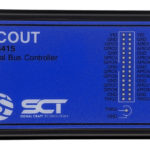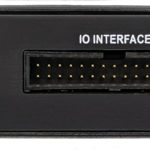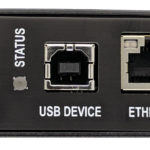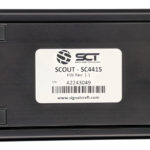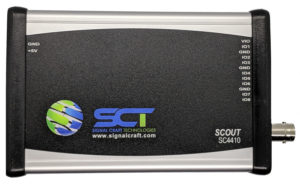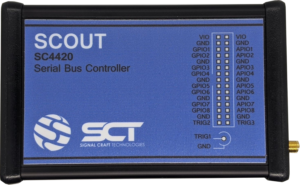Scout Model SC4415
Serial Bus Controller (MIPI-I3C and MIPI-RFFE)
Status: End of Life (Replaced by SC4420)

Key Features
- USB-to-Serial Bus Controller Provides Deterministic Serial Communications
- Supports MIPI-I3C (w/ Legary I2C), MIPI-RFFE(v2.1), and SPI
- Software-Selectable Clock Rates (mode dependent), Supporting 50 kHz to 52 MHz in 1 kHz Steps
- Several Triggering Modes
- 8 General Purpose I/O (GPIO)
- Designed for Manufacturing Environments
- Field Upgradeable
- Wide Operating Temperature Range (0 °C to 70 °C)
Typical Applications
- Design Verification Testing (DVT)
- High Volume Production Test
- RF Design and Characterization
The Scout SC4415 represents the next generation in the Scout product line. It incorporates enhanced features as well as support for SPI, I2C, MIPI-RFFE, and the MIPI-I3C protocols.
The device under test (DUT) interface incorporates serial bus, GPIO, and triggering functions on a standard dual row header. This format provides flexibility and more interconnect options, and also helps minimize noise coupling. The interface voltage (VIO) is software selectable. For non-standard interface voltages, Scout can be configured to accept an external reference source. Several triggered buffer modes provide scripting capability for high-speed test and verification applications. Triggering modes include internal via software command and three external via GPIO or the trigger input.
Scout instantiates itself as a standard COM port via USB. The unit supports manual operation using a terminal emulator or fully automated control in ATE environments via any programming language.
- MIPI-I3C (with Legacy I2C)
- MIPI-RFFE (version 2.1)
- SPI Modes 1 to 4
Sequencing and Timing
Scout was designed with determinism, low latency, and fast execution in mind. Timing-critical performance is achieved by using FPGA hardware and user-configurable command cues. Users can define a command sequence and trigger multiple executions of the sequence using either software or hardware triggers.
GPIO
Eight GPIO are available in all operating modes, and each one can be configured as either an input or an output. The GPIO commands can be embedded in the command queue and executed alongside other serial protocol commands. GPIO timing is deterministic.
External Supply
The adaptor can be powered via USB, eliminating the need for an external power supply. For applications where the USB host may be current starved, an external 5 Vdc power supply can be used to power the device.
Buffering and Trigger Modes
The SC4415 incorporates an instruction sequencer to accelerate high-volume production test applications. These high-capacity buffers can be recalled by activating one of several trigger modes. Two buffers of 2,048 instructions each can be filled and replayed in instruction sequencer style.



